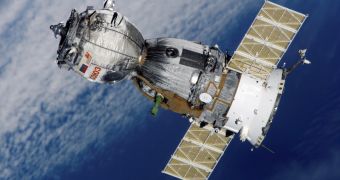Due to a slight glitch, the Soyuz TMA-11 spacecraft carrying the crew of Expedition 17 back to Earth landed way off target, several hundred miles away from the scheduled landing site. Although experiencing the action of severe G-forces, the crew is said to be safe and do not suffer any permanent medical problems, albeit Russian medical staff gave no details of their condition.
Upon re-entering Earth's atmosphere, the Soyuz spacecraft started to follow a steep descendent trajectory, making this the second time in a row when the Soyuz capsules behave unacceptably. According to mission control spokesman, Valery Lyndin, the crew was subjected to more than double the G-forces which would be experienced during a landing in normal conditions. 25 minutes after landing about 420 kilometers away from the designated location, the Soyuz capsule was located and the crew rescued.
"The most important thing is that the crew is healthy and well. The landing occurred normally, but according to a back-up plan - the descent was a ballistic trajectory," stated Federal Space Agency chief Anatoly Perminov in a press conference soon after the landing. It seems that the problems experienced during re-entry are due to an older glitch, because, since 2003, two other Soyuz capsules also behaved unusually during descent; however, Perminov says that the situation may have been avoidable if mission control would have been informed about the situation.
When asked about the superstition related to two women being on board the spacecraft, Perminov said: "You know is Russia, there are certain bad omens about this sort of thing, but thank God that everything worked out successfully. Of course, in the future we will work somehow to ensure that the number of women will not surpass. This isn't discrimination. I'm just saying that when a majority of the crew is female, sometimes certain kinds of unsanctioned behavior or something else occurs, that's what I'm talking about."
Yuri Malenchenko and Peggy Whitson are just returning from a six-month mission to the International Space Station, being part of what is known as Expedition 16, while Yi So-Yeon, the first South Korean astronaut in space, was flown to the ISS on April 10 along with the crew of Expedition 17, Sergei Volkov and Oleg Knonenko.
"I'm happy and feel grateful as she safely returned. I want to hug her, tell her: 'You worked hard'," said Yi's mother, Jung Geum-sun in an interview.
With the completion of Expedition 16, Peggy Whitson has become the American astronaut with the most cumulative time spent in space, 377 days.
In October last year, a similar Soyuz capsule suffered the same glitch during the return of three other astronauts, the first Malaysian in space and two Russian cosmonauts. Another incident took place in May 2003, when the capsule landed off target and experienced communication malfunctions, leaving the crew stranded for several hours before they were located.
Nonetheless, the Russian space program is recognized as extremely reliable, and is probably the safest space program of all. Spacecrafts such as Soyuz and Progress are testimony to the achievements of the Russian space program, proving extremely valuable especially during the months following the Columbia disaster, when all US space shuttles were grounded.

 14 DAY TRIAL //
14 DAY TRIAL //